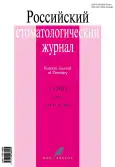Оценка качества жизни пациентов с абфракционными дефектами зубов
- Авторы: Шашмурина А.Б.1, Николаев А.И.1, Шашмурина В.Р.1, Лещева Е.А.2
-
Учреждения:
- Смоленский государственный медицинский университет
- Воронежский государственный медицинский университет имени Н.Н. Бурденко
- Выпуск: Том 27, № 3 (2023)
- Страницы: 183-192
- Раздел: Клинические исследования
- URL: https://journals.rcsi.science/1728-2802/article/view/131232
- DOI: https://doi.org/10.17816/dent356768
- ID: 131232
Цитировать
Аннотация
Обоснование. Актуальной представляется оценка эффективности лечения пациентов с абфракционными дефектами по критериям качества жизни.
Цель исследования — проанализировать результаты комплексного лечения пациентов с абфракционными дефектами зубов по критериям качества жизни.
Материалы и методы. Провели опрос-анкетирование 158 человек в возрасте 30–49 лет. Группу 1 (n=34) составляли пациенты, которым проводили эстетическую реставрацию зубов с использованием модифицированного адгезивного протокола (препарат на основе глутарового альдегида и адаптивный слой из текучего композита), применяли миорелаксирующую каппу. В группе 2 (n=36) проводили эстетическую реставрацию зубов с использованием модифицированного адгезивного протокола, не применяли миорелаксирующую каппу. В группе 3 (n=31) проводили эстетическую реставрацию зубов с использованием базового адгезивного протокола, применяли миорелаксирующую каппу. В группе 4 (n=27) проводили эстетическую реставрацию зубов с использованием базового адгезивного протокола, не применяли миорелаксирующую каппу. Группу 5 (n=30) составляли пациенты с интактными зубами. Оценку качества жизни проводили до начала лечения, через 6 мес и 1 год после лечения (прямой реставрации зубов). Использовали «Опросник качества жизни ОHIР-14» (Оral Health Imрact Рrоfile).
Результаты. Хороший исходный уровень качества жизни выявили у 35,2% пациентов с абфракционными дефектами, удовлетворительный — у 64,8%. Среднее интегральное значение суммы баллов качества жизни по группам 1–4 составило 12,9 (95% доверительный интервал: 12,4–13,3). Наибольший вклад в качество жизни внесла шкала «физическая боль» — 2,73 (95% доверительный интервал: 2,63–2,84). Через 12 мес после лечения у пациентов групп 1–4 выявили достоверное среднее снижение интегрального показателя OHIP-14 на 7,7%. Показатель OHIP-14 по шкале «физическая боль» снизился у пациентов группы 1 на 28,8%, группы 2 — на 25,2%, группы 3 — на 17,5%, группы 4 — на 13,2%.
Заключение. Клинические проявления абфракционных дефектов зубов оказывают существенное влияние на качество жизни пациентов по шкалам «физическая боль», «физический дискомфорт». Наилучшая динамика интегрального показателя качества жизни зарегистрирована у пациентов, в комплексном лечении которых использованы модифицированный адгезивный протокол и миорелаксирующая каппа.
Ключевые слова
Полный текст
Открыть статью на сайте журналаОб авторах
Анна Борисовна Шашмурина
Смоленский государственный медицинский университет
Email: shashmurina.ifivehbyf2011@yandex.ru
ORCID iD: 0000-0002-9705-1423
SPIN-код: 5121-4415
ассистент
Россия, СмоленскАлександр Иванович Николаев
Смоленский государственный медицинский университет
Автор, ответственный за переписку.
Email: anicolaev@inbox.ru
ORCID iD: 0000-0002-1378-6538
SPIN-код: 2687-8206
д.м.н., профессор
Россия, СмоленскВиктория Рудольфовна Шашмурина
Смоленский государственный медицинский университет
Email: shahmurina@yandex.ru
ORCID iD: 0000-0001-5216-7521
SPIN-код: 4199-4204
д.м.н., профессор
Россия, СмоленскЕлена Александровна Лещева
Воронежский государственный медицинский университет имени Н.Н. Бурденко
Email: el.leshewa@yandex.ru
ORCID iD: 0000-0001-6290-6551
SPIN-код: 1068-1617
д.м.н., профессор
Россия, ВоронежСписок литературы
- Albar N.H. Efficacy of GLUMA for the treatment of dentin hypersensitivity compared to lasers: A systematic review // J Contemp Dent Pract. 2022. Vol. 23, N 10. P. 1057–1065. doi: 10.5005/jp-journals-10024-3420
- Olaru A.R., Popescu M.R., Dragomir L.P., Rauten A.M. Clinical study on abfraction lesions in occlusal dysfunction // Curr Health Sci J. 2019. Vol. 45, N 4. P. 390–397. doi: 10.12865/CHSJ.45.04.07
- Кулаков А.А., Климашин Ю.И., Андреева С.Н., Руденко К.Н. Вопросы качества жизни в ортопедической стоматологии // Стоматология для всех. 2006. № 3. С. 4–5.
- Новик А.А., Ионова Т.И. Руководство по исследованию качества жизни в медицине. Санкт-Петербург : Нева, 2002.
- Садыкова О.М., Жолудев С.Е., Еликов А.В. Качество жизни как показатель эффективности малой бальнеотерапии у пациентов, пользующихся съёмными протезами // Проблемы стоматологии. 2018. Т. 14, № 3. С. 49–55. doi: 10.18481/2077-7566-2018-14-3-49-55
- Янушевич О.О., Гуревич К.Г., Панин А.М., и др. Руководство по оценке качества жизни в стоматологии. Москва : ГЭОТАР-Медиа, 2021.
- Попов В.А., Выборова П.С., Гордиенко А.А., и др. Качество жизни, связанное со стоматологическим здоровьем: исследование среди студентов медицинского университета в Арктической зоне России // Экология человека. 2020. № 6. С. 46–57. doi: 10.33396/1728-0869-2020-6-46-57
- Slade G.D., Spenser A.J. Development and evaluation of the Oral Health Impact Profile // Community Dent Health. 1994. Vol. 11, N 1. P. 3–11.
- Campos L.A., Peltomäki T., Marôco J., Campos J.A.D.B. Use of Oral Health Impact Profile-14 (OHIP-14) in different contexts. What is being measured? // Int J Environ Res Public Health. 2021. Vol. 18, N 24. 13412. doi: 10.3390/ijerph182413412
- Барер Г.М., Гуревич К.Г., Смирнягина В.В., Фабрикант Е.Г. Использование стоматологических измерений качества жизни // Стоматология для всех. 2006. № 2. C. 4–7.
- Гилева О.С., Либик Т.В., Халилаева Е.В., и др. Стоматологическое здоровье в критериях качества жизни // Медицинский вестник Башкортостана. 2011. Т. 6, № 3. С. 6–11.
- Чикунов С.О., Дзалаева Ф.К., Утюж А.С., и др. Качество жизни пациентов с признаками патологии височно-нижнечелюстного сустава при проведении комплексной стоматологической ортопедической реабилитации // Проблемы стоматологии. 2020. Т. 16, № 2. С. 144–150. doi: 10.18481/2077-7566-20-16-2-144-150
Дополнительные файлы












